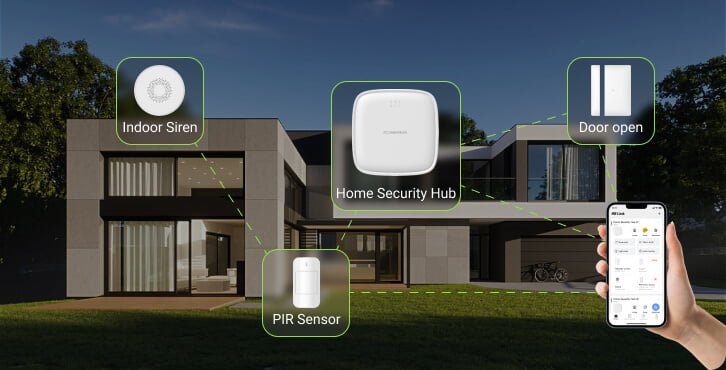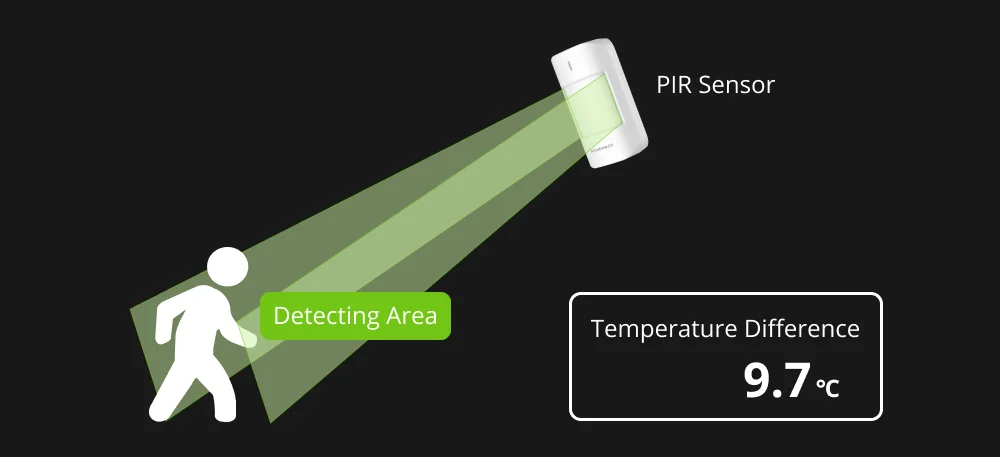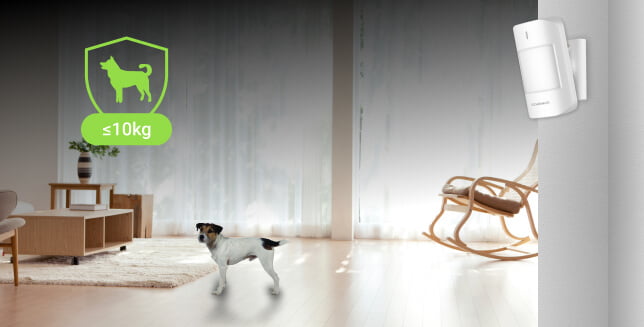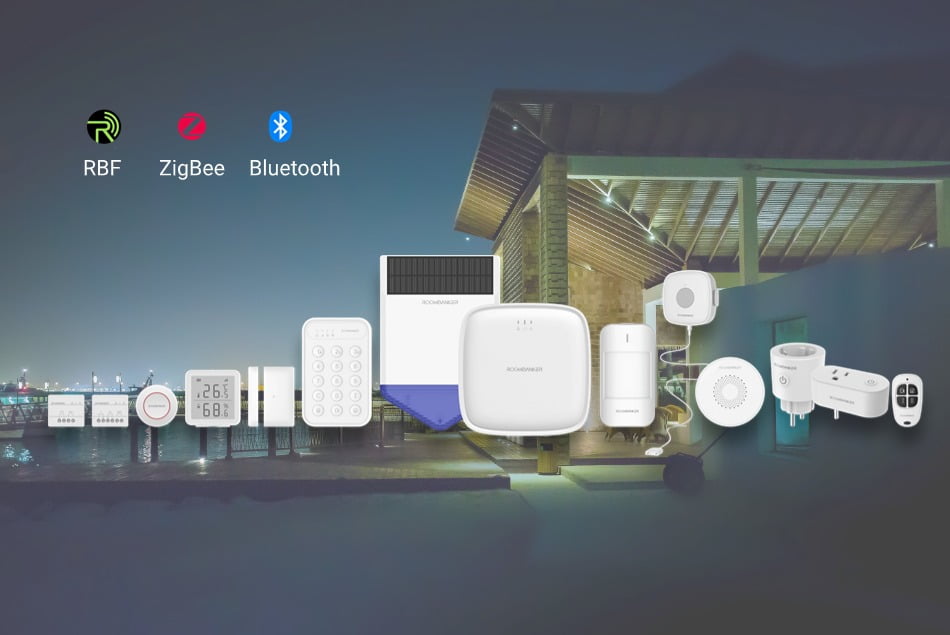Maybe you are considering enhancing your current security product lineup with advanced burglar alarm systems? While CCTV video surveillance is undeniably crucial in today’s home security landscape, integrating a complete intruder alarm system can significantly elevate your security offerings.
These systems, composed of PIR motion sensors, door and window contacts, glass break sensors, and other components, provide a more holistic approach to safeguarding homes. This article delves into the various types of motion detectors available on the market today, guided by the expertise of the Roombanker product management team, who bring extensive experience in the alarm industry.

What is a Motion Detector?
In the realm of modern smart security systems, Passive Infrared Sensors (PIR) have emerged as fundamental components in both residential and commercial security solutions. These sensors work by detecting human movement through changes in ambient infrared radiation. As technology progresses, PIR motion detectors have evolved into composite sensors, integrating multiple technologies to improve detection accuracy. Now, let’s explore these different types of motion sensors, and gain insights into their functionalities and advantages.

Also read: what is Passive Infrared Sensors (PIR)?
Basic PIR Motion Detectors
Despite being labeled as “basic,” PIR motion detectors used in the alarm industry are anything but simple. Unlike PIR sensors commonly found in general smart home applications, those designed for security systems boast a multitude of advanced features.
PIR alarm sensors are a sophisticated hybrid of optics, structural design, and algorithms. At the heart of these detectors is the Fresnel lens, a crucial optical component characterized by its intricate texture design, which directly influences detection accuracy.
Generally, the smaller the sector granularity, the higher the accuracy of detection. Unlike the general PIR sensors used in smart home setups, which may do not employ sectors due to cost considerations, alarm industry PIR detectors exhibit this feature. Moreover, for households with pets, it’s essential that the Fresnel lens is designed to be pet-immune.
Also read: what is pet-friendly PIR sensor?

The structural design of PIR detectors considers factors such as size and appearance. For instance, outdoor PIR motion detectors face specific challenges like direct sunlight exposure, which can age the lens over time, leading to diminished detection capability or failure. Therefore, outdoor PIR motion detectors usually have a cap to protect the lens from prolonged exposure to harsh environmental conditions.
Algorithms further enhance the intelligence of PIR motion detectors, but the key to their superior performance remains the design of the Fresnel lens.
Dual-tech Motion Detectors
Despite the extensive considerations in basic PIR alarm sensors, real-world applications reveal a persistent issue: frequent false alarms. To address this, dual-tech PIR sensors were developed, integrating an additional technology to verify alarms and ensure accurate triggering.
The most prevalent dual-tech PIR sensors combine passive infrared (PIR) with microwave sensing technologies. In this setup, the PIR component detects changes in ambient infrared radiation, whereas the microwave sensor identifies moving objects by emitting and receiving microwave signals. Due to the high power consumption of the microwave component, it is typically activated by the PIR sensor. The operational logic is sequential: when a person or object enters the monitored zone, the PIR sensor detects infrared heat changes, prompting the microwave sensor to verify movement. An alarm is only triggered when both sensors concurrently detect motion. This design significantly diminishes false alarms that typically arise from single-sensor usage.
Another variation in dual-tech motion detectors is the combination of PIR and glass break sensors. This sensor is specifically designed to identify glass breakage events and other potential intrusions. It is particularly suited for installation near windows or other glass structures. When someone approaches the glass area, the PIR sensor detects variations in infrared radiation caused by changes in body heat. Simultaneously, a high-sensitivity microphone continuously monitors ambient sound waves, and upon detecting the characteristic audio spectrum and intensity change associated with glass breaking, it further confirms and issues an alarm. This dual detection capability effectively reduces false alarm rates, ensuring alarms are triggered only during genuine intrusion events.
Tri-tech Motion Detectors
In complex outdoor environments, tri-tech motion detectors are also available, offering an additional layer of detection. Building upon the capabilities of dual-tech detectors, tri-tech detectors introduce an additional layer of intelligent processing, often facilitated by microprocessors, along with a sophisticated multi-layer verification mechanism.
In these advanced sensors, when the infrared component detects a change in temperature, it activates the microwave sensing circuit for further verification. If the microwave sensor confirms the presence of a moving target, the signals undergo intelligent analysis by the microprocessor. Only when these signals meet specific, predefined criteria will an alarm signal be issued.
This rigorous multi-layer verification process greatly enhances detection accuracy, allowing for precise operation even in challenging environments characterized by dramatic lighting changes or frequent airflows.
PIR Camera Sensors
While the previously mentioned methods employ various technologies to detect suspicious intrusions, integrating a camera may offer a more direct approach and serve as a stronger deterrent.
The PIR camera sensor combines one or more passive infrared sensors with a camera. Once the PIR sensor detects movement from a person or object, the camera is triggered to capture images, which are then uploaded to the cloud to be compiled into animated sequences. This system can transmit alert information and visual data to the user’s device via a wireless module, allowing for video verification of alarm events. By activating only when necessary, this solution considerably reduces the generation of unnecessary data associated with constant 24/7 recording, thereby decreasing both storage and data processing requirements, while also enhancing privacy.
PIR camera sensors enable a rapid response by initiating video surveillance and on-site recording promptly. In addition, they typically support remote monitoring, allowing users to access surveillance footage anytime through a smartphone or computer to address situations as needed.
Despite the effectiveness of PIR sensors with cameras, there remain certain concerns. For instance, there are scenarios where the PIR sensor detects an intrusion but the camera fails to capture an image. This can result from the image capture speed defined in the software, or due to design factors such as camera angle and clarity. Additionally, capturing images at night can be challenging if the intruder is wearing dark clothing, leading some PIR cameras to include features like supplemental white light to improve image capture in low-light conditions.
Curtain PIR Detectors
The curtain PIR detector is meticulously engineered to monitor narrow areas, such as windows, doors, or corridor entrances, where homeowners want to prevent any unauthorized crossing. This sensor’s technical makeup includes a passive infrared sensor (PIR), a wireless communication module, and an intelligent processing unit. It uses a specially designed infrared curtain to accurately detect objects traversing a defined narrow horizontal range. When an object breaks this infrared curtain, the PIR sensing module identifies the disruption in infrared radiation due to temperature change. The intelligent processing unit then analyzes the signal, effectively filtering out interferences like small animals or transient temperature fluctuations. An alert is only sent via the wireless module if the signal meets the predefined intrusion criteria.
The advantages of the curtain PIR sensor include precise detection in narrow areas and low false alarm rates. By focusing on activity through a “curtain,” it adeptly distinguishes between actual intrusions and ordinary environmental changes. Its flexible installation options make it suitable for a variety of complex scenarios, especially where precise boundary monitoring is essential, such as at windows and doorways.
Furthermore, the curtain PIR sensor typically incorporates anti-masking technology to enhance its performance in complex environments. The anti-masking feature provides alerts if the sensor is obstructed or covered, ensuring that there are no blind spots due to human interference or accidental coverage. With this comprehensive blend of technologies, the wireless PIR anti-masking curtain sensor delivers an efficient, adaptable, and secure monitoring solution for users.
Ceiling-mounted PIR Sensors
The ceiling PIR ceiling sensor is ideal for monitoring large indoor spaces and is typically installed on the ceiling, operating in a “cone-shaped downward” detection mode to effectively cover the entire area below. When someone enters its monitoring range, the infrared sensor detects changes in infrared radiation caused by body heat. This information is processed by the intelligent processing unit, and if it meets specific movement or intrusion criteria, an alert is transmitted via the wireless module to the relevant system or device. The ceiling-mounted design enables the sensor to oversee the entire room without being obstructed by furniture or other obstacles.
The primary advantage of the ceiling PIR sensor is its extensive monitoring range and low intrusiveness in the space. Being ceiling-mounted provides a broad field of view, making it an ideal choice for large spaces such as offices and living rooms.
Double PIR Sensors
Unlike the earlier mentioned dual-tech PIR sensors, which combine multiple technologies, double PIR sensors utilize two PIR sensors, both relying on a single technology.
The double PIR sensor features two Fresnel lenses positioned at different heights, one above the other, enabling the device to effectively detect vertical motion within the monitored area, thereby achieving high-precision motion detection. When an individual moves through the sensor’s zone, various factors, such as height and body type, typically activate both the upper and lower PIR sensors simultaneously. The sensors detect body heat at both levels and capture nearly synchronous signal changes. The device’s processor receives signals from both sensors, performs data comparison and analysis, and determines if there is a simultaneous temperature change and if the change pattern corresponds to human movement.
In contrast, small animals like cats and dogs generally enter only the lower PIR sensor’s detection range, with the upper sensor often not registering significant changes. Consequently, when the processor compares the data from both sensors, it only identifies changes from a single signal source. This singular signal change usually doesn’t trigger an alarm, as the system is configured to only alert when both the upper and lower PIR sensors simultaneously detect a movement pattern. This dual detection and intelligent analysis mechanism distinguishes actual intrusions, allowing the double PIR sensor to maintain high sensitivity while significantly reducing false alarms caused by environmental factors or small animals, providing users with a stable and reliable security solution.
Final Words – Roombanker is a Burglar Alarm Manufacturer and Welcome Distribution
From basic PIR sensors to dual-tech, tri-tech, PIR camera sensors, ceiling-mounted PIR sensors, and double PIR sensors, a wide array of methods are employed to enhance the capabilities of PIR sensors, making them more powerful while minimizing false alarms.
Roombanker, a trusted manufacturer of intrusion alarm devices, offers high-accuracy PIR motion detectors that boast numerous features designed to enhance accuracy and incorporate pet-friendly designs. Our sensors efficiently differentiate between human and small animal movements, significantly reducing false alarms and providing users with a peace of mind. We are actively seeking alarm distributors globally and invite you to consult our specific distribution policy for more details.

